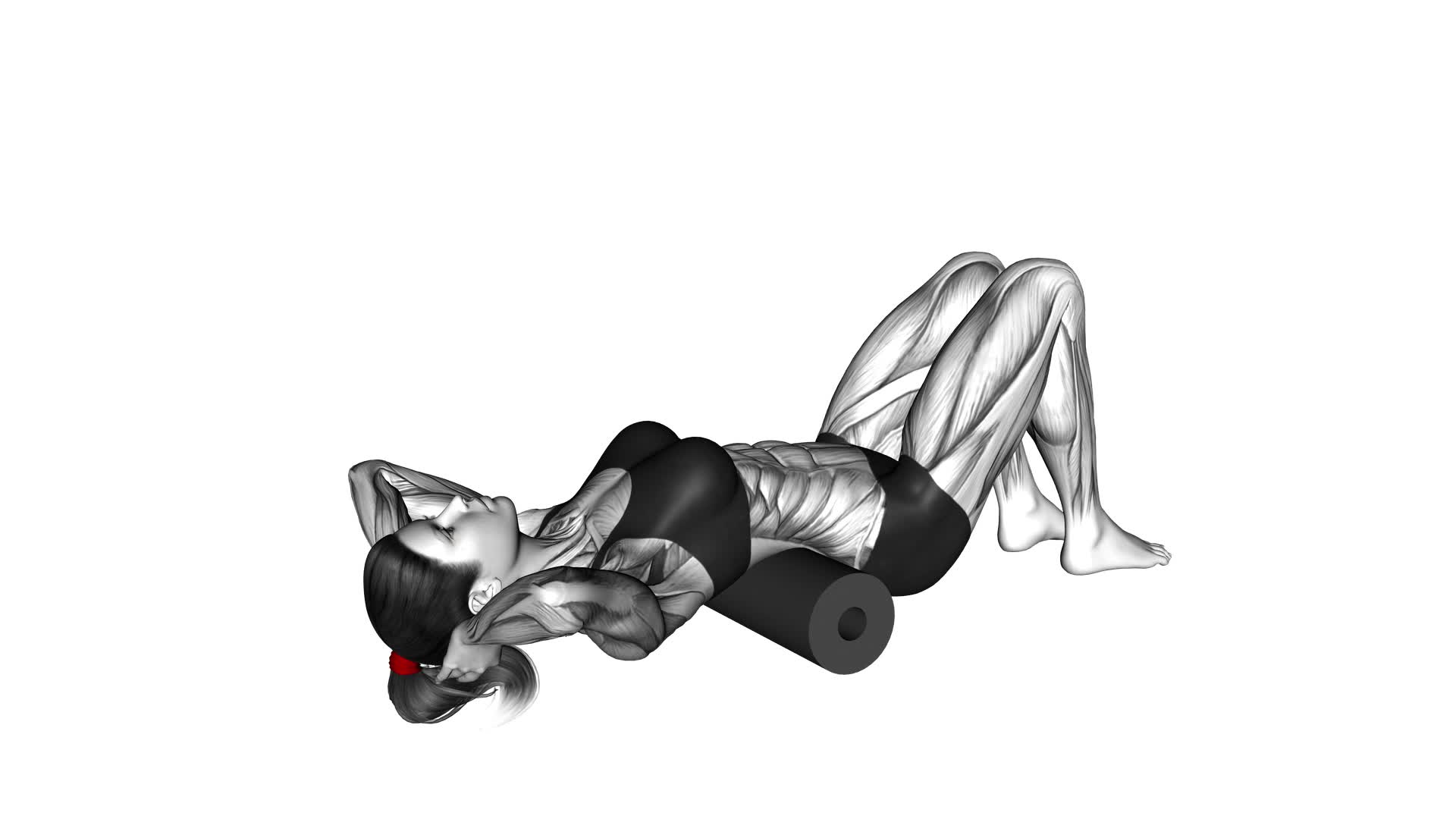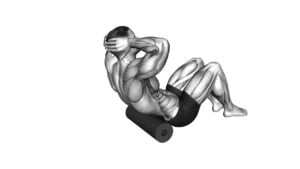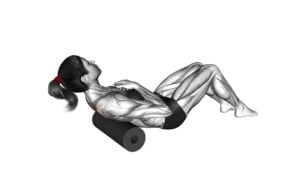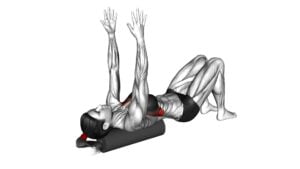Roll Thoracic Spine Lying on Floor (female) – Video Exercise Guide & Tips

Ready to relieve tension and improve your posture?
Watch This Exercise Video
Learn how to roll your thoracic spine lying on the floor with this video exercise guide and helpful tips.
By actively engaging in this exercise, you'll experience the benefits of increased mobility and flexibility in your upper back.
Avoid common mistakes and maximize the effectiveness of this exercise by following our step-by-step guide.
Get ready to feel the difference and improve your overall well-being.
Let's get started!
Key Takeaways
- Rolling the thoracic spine improves posture
- Rolling the thoracic spine increases flexibility
- Rolling the thoracic spine releases tension and tightness
- Rolling the thoracic spine reduces the risk of developing muscle imbalances
Benefits of Rolling the Thoracic Spine
Roll your thoracic spine on the floor to experience the numerous benefits it offers. Rolling the thoracic spine can greatly improve your posture and increase your flexibility.
The thoracic spine is located in the middle of your back and is responsible for maintaining proper alignment and stability. By rolling this area, you can release tension and tightness, allowing for better posture throughout the day.
Additionally, rolling the thoracic spine can help increase flexibility in the surrounding muscles, making it easier to perform daily activities and exercise with proper form. This exercise is especially beneficial for those who spend long hours sitting or have a sedentary lifestyle, as it can counteract the negative effects of prolonged sitting.
By incorporating thoracic spine rolling into your routine, you can enhance your overall body alignment and reduce the risk of developing muscle imbalances.
Now that you understand the benefits, let's move on to the preparation and set-up for the exercise.
Preparation and Set-Up for the Exercise
To prepare and set up for the exercise:
- Lie on your back on the floor and position yourself in a comfortable and relaxed position.
- Ensure proper alignment by keeping your feet hip-width apart and flat on the floor, with your knees bent.
- Relax your arms by your sides, palms facing down.
To further enhance your preparation:
- Take a moment to focus on your breathing.
- Inhale deeply through your nose, allowing your belly to rise.
- Exhale through your mouth, releasing any tension in your body.
When you're ready to start:
- Engage your core muscles by gently drawing your belly button towards your spine.
- Keep your neck and shoulders relaxed throughout the exercise.
Remember:
- Proper alignment and preparation techniques are crucial for getting the most out of the roll thoracic spine exercise.
- Starting in a comfortable and relaxed position, focusing on your breathing, and engaging your core will help you perform the exercise more effectively.
- These steps will also reduce the risk of injury.
Step-by-Step Guide to Rolling the Thoracic Spine
Lie on your back on the floor and position yourself in a comfortable and relaxed position to begin rolling your thoracic spine. This rolling technique is a great way to improve thoracic mobility, which is important for maintaining proper posture and preventing back pain.
To start, bend your knees and place your feet flat on the floor. Keep your arms relaxed by your sides. Take a deep breath in and as you exhale, gently engage your core muscles. Slowly begin to tilt your pelvis upward, lifting your lower back off the floor.
Next, slowly roll your spine upward, one vertebra at a time, until you reach your upper back. Pause for a moment, and then slowly reverse the movement, rolling back down to the starting position.
As you roll, focus on maintaining a smooth and controlled motion. Avoid any jerky movements or rushing through the exercise.
Repeat this rolling movement for 8-10 repetitions, and then take a moment to relax and breathe. This exercise can be performed daily to improve thoracic mobility and reduce tension in the upper back.
Remember to listen to your body and stop if you experience any pain or discomfort. Consult with a healthcare professional if you have any concerns or pre-existing conditions.
Common Mistakes to Avoid
To maximize the effectiveness of this exercise, it's important to frequently check for and avoid common mistakes. Here are some common mistakes to watch out for and tips for maintaining proper form:
- Rushing the movement: Avoid rushing through the exercise. Take your time and focus on each roll to ensure proper alignment and engagement of the thoracic spine.
- Lifting the head: Keep your head relaxed on the floor throughout the exercise. Lifting the head can strain the neck and take away from the intended stretch in the thoracic spine.
- Using momentum: Avoid using momentum to roll from side to side. Instead, use controlled movements to engage the muscles in the thoracic spine and maintain stability.
- Neglecting the breath: Remember to breathe deeply and rhythmically throughout the exercise. Proper breathing helps to relax the muscles and enhance the effectiveness of the roll.
- Overarching the lower back: Be mindful of your lower back position. Avoid overarching or excessive arching of the lower back, as it can lead to discomfort and strain.
By being aware of these common mistakes and maintaining proper form, you can maximize the effectiveness of the roll thoracic spine exercise.
Now, let's move on to the next section for tips on how to further enhance the benefits of this exercise.
Tips for Maximizing the Effectiveness of the Exercise
To maximize the effectiveness of the exercise, you can incorporate these tips into your routine.
First, focus on maintaining proper form throughout the movement. Keep your core engaged and your spine in a neutral position to ensure that you're targeting the right muscles and minimizing the risk of injury.
Additionally, make sure to breathe deeply and exhale fully as you roll your thoracic spine on the floor. This will help you to relax and release tension in the muscles surrounding your spine.
To further maximize results, consider incorporating variations and modifications into your routine.
One variation you can try is using a foam roller or a massage ball to roll your thoracic spine. This can provide a deeper stretch and massage effect, increasing the effectiveness of the exercise.
Another modification you can make is to adjust the speed at which you roll. Experiment with slower and faster movements to target different muscle fibers and challenge your body in new ways.
Remember to listen to your body and make adjustments as needed. If you feel any pain or discomfort, stop the exercise and consult with a healthcare professional.
Frequently Asked Questions
How Long Should I Hold the Rolled Position When Rolling the Thoracic Spine?
When rolling your thoracic spine, it's important to hold the rolled position for the right amount of time. To ensure proper technique, focus on maintaining the position for a few seconds before moving on. This allows your spine to fully benefit from the exercise.
Remember to listen to your body and start with shorter holds, gradually increasing the duration as you feel more comfortable. Consistency and patience are key when it comes to mastering the thoracic spine roll.
Can Rolling the Thoracic Spine Help With Posture Improvement?
Rolling the thoracic spine can indeed help improve your posture. By performing this exercise, you're promoting thoracic mobility, which is essential for maintaining proper alignment and reducing the risk of postural imbalances.
Rolling your thoracic spine helps to release tension, improve spinal flexibility, and increase range of motion. This, in turn, can lead to improved posture correction and overall better alignment of your spine.
Is It Normal to Feel Some Discomfort or Tightness While Rolling the Thoracic Spine?
Feeling discomfort or tightness while rolling your thoracic spine is normal. This is because the exercise involves stretching and mobilizing the muscles and joints in that area. It's like giving your spine a good massage.
However, if the discomfort is severe or persists, it's important to listen to your body and stop the exercise. It's always a good idea to consult with a professional if you have any concerns or if the discomfort becomes too much to bear.
Are There Any Specific Breathing Techniques to Follow During the Exercise?
During the exercise, it's important to focus on your breathing techniques. This can help you relax and enhance the benefits of thoracic spine rolling for athletes.
Take deep breaths in and out as you roll your spine on the floor. Inhale as you roll back and exhale as you roll forward.
This rhythmic breathing can promote better movement and release tension in your thoracic spine.
Can Rolling the Thoracic Spine Be Beneficial for Individuals With Pre-Existing Back Conditions Such as Herniated Discs or Scoliosis?
Rolling the thoracic spine can be beneficial for individuals with pre-existing back conditions such as herniated discs or scoliosis. It helps to improve spinal mobility and flexibility, which can alleviate pain and discomfort.
However, it's important to take precautions and consult with a healthcare professional before attempting this exercise. They can provide guidance and modifications to ensure your safety.
Conclusion
Rolling the thoracic spine on the floor is a beneficial exercise for improving spinal mobility and relieving tension. By following the step-by-step guide and avoiding common mistakes, you can maximize the effectiveness of this exercise.
Remember to prepare and set up properly before starting. With practice, this exercise can help you maintain a healthy thoracic spine and overall posture.

Author
Years ago, the spark of my life’s passion ignited in my mind the moment I stepped into the local gym for the first time. The inaugural bead of perspiration, the initial endeavor, the very first surge of endorphins, and a sense of pride that washed over me post-workout marked the beginning of my deep-seated interest in strength sports, fitness, and sports nutrition. This very curiosity blossomed rapidly into a profound fascination, propelling me to earn a Master’s degree in Physical Education from the Academy of Physical Education in Krakow, followed by a Sports Manager diploma from the Jagiellonian University. My journey of growth led me to gain more specialized qualifications, such as being a certified personal trainer with a focus on sports dietetics, a lifeguard, and an instructor for wellness and corrective gymnastics. Theoretical knowledge paired seamlessly with practical experience, reinforcing my belief that the transformation of individuals under my guidance was also a reflection of my personal growth. This belief holds true even today. Each day, I strive to push the boundaries and explore new realms. These realms gently elevate me to greater heights. The unique combination of passion for my field and the continuous quest for growth fuels my drive to break new ground.







